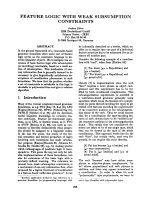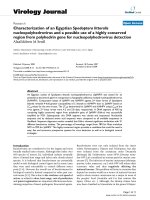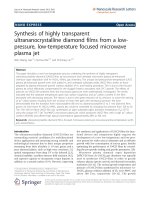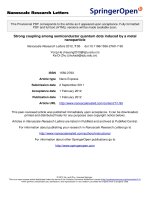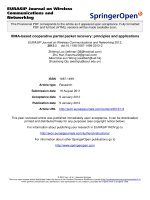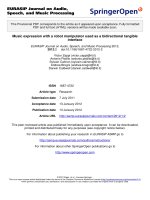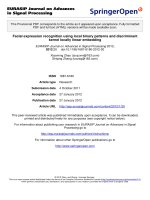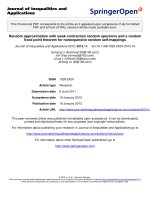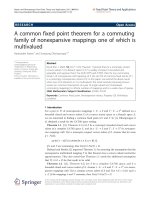Báo cáo toán học: " Random approximation with weak contraction random operators and a random fixed point theorem for nonexpansive random self-mappings" pptx
Bạn đang xem bản rút gọn của tài liệu. Xem và tải ngay bản đầy đủ của tài liệu tại đây (205.66 KB, 14 trang )
This Provisional PDF corresponds to the article as it appeared upon acceptance. Fully formatted
PDF and full text (HTML) versions will be made available soon.
Random approximation with weak contraction random operators and a random
fixed point theorem for nonexpansive random self-mappings
Journal of Inequalities and Applications 2012, 2012:16 doi:10.1186/1029-242X-2012-16
Suhong Li ()
Xin Xiao ()
Lihua Li ()
Jinfeng Lv ()
ISSN 1029-242X
Article type Research
Submission date 9 June 2011
Acceptance date 19 January 2012
Publication date 19 January 2012
Article URL />This peer-reviewed article was published immediately upon acceptance. It can be downloaded,
printed and distributed freely for any purposes (see copyright notice below).
For information about publishing your research in Journal of Inequalities and Applications go to
/>For information about other SpringerOpen publications go to
Journal of Inequalities and
Applications
© 2012 Li et al. ; licensee Springer.
This is an open access article distributed under the terms of the Creative Commons Attribution License ( />which permits unrestricted use, distribution, and reproduction in any medium, provided the original work is properly cited.
Random approximation with weak contrac-
tion random operators and a random fixed
point theorem for nonexpansive random self-
mappings
Suhong Li
1∗,2
, Xin Xiao
1
, Lihua Li
1
and Jinfeng Lv
1
1
College of Mathematics and Information Technology, Hebei Normal University of Science and
Technology,
Qinhuangdao Hebei 066004, China
2
Institute of Mathematics and Systems Science, Hebei Normal University of Science and
Technology,
Qinhuangdao Hebei 066004, China
∗
Correspondingauthor:
Email address:
XX:
LL:
JL:
1
Abstract
In real reflexive separable Banach space which admits a weakly sequentially continu-
ous duality mapping, the sufficient and necessary conditions that nonexpansive ran-
dom self-mapping has a random fixed point are obtained. By introducing a random
iteration process with weak contraction random operator, we obtain a convergence
theorem of the random iteration process to a random fixed point for nonexpansive
random self-mappings.
1 Introduction
Random nonlinear analysis is an important mathematical discipline which is
mainly concerned with the study of random nonlinear operators and their prop-
erties and is much needed for the study of various classes of random equations.
Random techniques have been crucial in diverse areas from puremathematics
to applied sciences. Of course famously random methods have revolutionised
the financial markets. Random fixed point theorems for random contraction
mappings on separable complete metric spaces were first proved by Spacek [1].
The survey article by Bharucha-Reid [2] in 1976 attracted the attention of sev-
eral mathematician and gave wings to this theory. Itoh [3] extended Spacek’s
theorem to multivalued contraction mappings. Now this theory has become the
full fledged research area and various ideas associated with random fixed point
theory are used to obtain the solution of nonlinear random system (see [4]). Re-
cently Beg [5,6], Beg and Shahzad [7] and many other authors have studied the
fixed points of random maps. Choudhury [8], Park [9], Schu [10], and Choud-
2
hury and Ray [11] had used different iteration processes to obtain fixed points
in deterministic operator theory. In this article, we study a random iteration
process with weak contraction random operator and obtain the convergence the-
orem of the random iteration process to a random fixed point for nonexpansive
random self-mapping. Our main results are the randomizations of most of the
results of the recent articles by Song and Yang [12], Song and Chen [13], and
Xu [14]. In particular these results extend the corresponding results of Beg and
Abbas [15].
2 Preliminaries
Let X be Banach space, we denote its norm by · and its dual space by X
∗
.
The value of x
∗
∈ X
∗
at y ∈ X is denoted by y, x
∗
, and the normalized duality
mapping from X into 2
X
∗
is denoted by J, that is,
J(x) = {f ∈ X
∗
: x, f = xf, x = f }, for all x ∈ X.
A Banach space X is said to be (i) strictly convex if x = y = 1, x = y
implies
x+y
2
< 1;
(ii) unif ormly convex if for all ε ∈ [0, 2], there exists δ
ε
> 0 such that
x = y = 1 with x − y ≥ ε implies
x+y
2
< 1 − δ
ε
.
It is well known that each uniformly convex Banach space X is reflexive
and strictly convex. Typical examples of both uniformly convex and uniformly
smooth Banach spaces are L
p
spaces, where p > 1.
Recall that J is said to be weakly sequentially continuous, if for each {x
n
} ⊂
X with x
n
x, then J(x
n
)
∗
J(x).
Recall that a Banach space X is said to satisfy Opial
s condition if, for any
{x
n
} ⊂ X with x
n
x, the following inequality holds:
lim inf
n→∞
x
n
− x < lim inf
n→∞
x
n
− y
3
for y ∈ X with y = x. It is well known that the above inequality is equivalent
to
lim sup
n→∞
x
n
− x < lim sup
n→∞
x
n
− y
for y ∈ X with y = x.
It is well known that all Hilbert spaces and l
p
(p > 1) spaces satisfy Opial’s
condition, while L
p
spaces does not unless p = 2.
Remark 2.1. If X admits a weakly sequentially continuous duality mapping,
then X satisfies Opial’s condition, and X is smooth, for the details, see [16].
Let (Ω, Σ) be a measurable space (Σ-sigma algebra) and F be a nonempty
subset of a Banach space X. A mapping ξ : Ω → X is measurable if ξ
−1
(U) ∈ Σ
for each open subset U of X. The mapping T : Ω × F → F is a random map if
and only if for each fixed x ∈ F , the mapping T (·, x) : Ω → F is measurable, and
it is continuous if for each ω ∈ Ω, the mapping T (ω, ·) : F → X is continuous.
A measurable mapping ξ : Ω → X is the random fixed point of the random
map T : Ω × F → X if and only if T (ω, ξ(ω)) = ξ(ω), for each ω ∈ Ω.
Throughout this article, we denote the set of all random fixed points of
random mapping T by RF (T ), the set of all fixed points of T (ω, ·) by F(T (ω, ·))
for each ω ∈ Ω, respectively.
Definition 2.1. Let F be a nonempty subset of a separable Banach space X
and T : Ω × F → F be a random map. The map T is said to be:
(a) weakly contractive random operator if for arbitrary x, y ∈ F ,
T (ω, x) − T (ω, y) ≤ x − y − ϕ(x − y)
for each ω ∈ Ω, where ϕ : [0, ∞) → [0, ∞) is a continuous and nondecreasing
map such that ϕ(0) = 0, and lim
t→∞
ϕ(t) = ∞.
(b) nonexpansive random operator if for each ω ∈ Ω, such that for arbitrary
4
x, y ∈ F we have
T (ω, x) − T (ω, y) ≤ x − y
(c) completely continuous random operator if the sequence {x
n
} in F con-
verges weakly to x
0
implies that {T (ω, x
n
)} converges strongly to T (ω , x
0
) for
each ω ∈ Ω.
(d) demiclosed random operator (at y) if {x
n
} and {y
n
} are two sequences
such that T (ω, x
n
) = y
n
and {x
n
} converges weakly to x and {T (ω, x
n
)} con-
verges to y imply that x ∈ F and T (ω, x) = y, for each ω ∈ Ω.
Definition 2.2. Let T : Ω × F → F be a nonexpansive random operator,
f : Ω × F → F be a weakly contractive random operator, F is a nonempty
convex subset of a separable Banach space X. For each t ∈ (0, 1), the random
iteration scheme with weakly contractive random operator is defined by
ξ
t
(ω) = (1 − t)f(w, ξ
t
(ω)) + tT (ω, ξ
t
(ω))
for each ω ∈ Ω. Since F is a convex set, it follows that for each t ∈ (0, 1), ξ
t
is
a mapping from Ω to F .
Remark 2.2. Let F be a closed and convex subset of a separable Banach space
X and the random iteration scheme {ξ
t
} defined as in Definition 2.2 is pointwise
convergent, that is, ξ
t
(ω) → q := ξ(ω) for each ω ∈ Ω. Then closedness of F
implies ξ is a mapping from Ω to F . Since F is a subset of a separable Banach
space X, so, if T is a continuous random operator then by [17, Lemma 8.2.3],
the map ω → T (ω, f(ω)) is a measurable function for any measurable function
f from Ω to F . Thus {ξ
t
} is measurable. Hence ξ : Ω → F , being the limit of
{ξ
t
}, is also measurable.
Lemma 2.1.( [15]). Let F be a closed and convex subset of a complete separable
metric space X, and T : Ω × F → F be a weakly contractive random operator.
Then T has unique random fixed point.
5
Lemma 2.2. Let X be a real reflexive separable Banach space which satisfies
Opial’s condition. Let K be a nonempty closed convex subset of X, and T :
Ω × K → K is nonexpansive random mapping. Then, I − T is demiclosed at
zero.
Proof From Zhou [18], it is easy to imply the conclusion of Lemma 2.2 is valid.
3 Main results
Theorem 3.1 Let X be a real reflexive separable Banach space which admits
a weakly sequentially continuous duality mapping from X to X
∗
, and K be
a nonempty closed convex subset of X. Suppose that T : Ω × K → K is
nonexpansive random mapping and f : Ω × K → K is a weakly contractive
random mapping with a function ϕ, then
(i) for each t ∈ (0, 1), there exists a unique measurable mapping ξ
t
from Ω
into X such that
ξ
t
(ω) = tf(ω, ξ
t
(ω)) + (1 − t)T (ω, ξ
t
(ω))
for each ω ∈ Ω.
(ii) T has a random fixed point if and only if {ξ
t
(ω)} is bounded as t → 0 for
each ω ∈ Ω. In this case, {ξ
t
} converges strongly to some random fixed point
ξ
∗
of T such that ξ
∗
is the unique random solution in RF (T ) to the following
variational random inequality:
(f −I)(w, ξ
∗
(ω)), j(ξ(w)−ξ
∗
(ω)) ≤ 0, for all ξ ∈ RF (T ) and each ω ∈ Ω.
(3.1)
Proof For each t ∈ (0, 1), we define a random mapping S
t
: Ω × K → K
by S
t
(ω, x) = tf(ω, x) + (1 − t)T (ω, x) for each (ω, x) ∈ Ω × K, then for any
6
x, y ∈ K and each ω ∈ Ω, and ψ(·) = tϕ(·) we have
S
t
(ω, x) − S
t
(ω, y)
≤ tf (ω, x) − f (ω, y) + (1 − t)T (ω, x) − T (ω, y)
≤ tx − y + (1 − t)x − y − tϕ(x − y)
= x − y − tϕ(x − y)
= x − y − ψ(x − y)
Thus, S
t
: Ω × K → K is a weakly contractive random mapping with a function
ψ, it follows from Lemma 2.1 that there exists a unique random fixed point of
S
t
, say ξ
t
such that for each ω ∈ Ω,
ξ
t
(ω) = tf(ω, ξ
t
(ω)) + (1 − t)T (ω, ξ
t
(ω)) (3.2)
This completes the proof of (i).
Next we shall show the uniqueness of the random solution of the variational
random inequality (3.1) in RF (T ). In fact, suppose ξ
1
(ω), ξ
2
(ω) ∈ RF (T ) satisfy
(3.1), we see that
(f − I)(ω, ξ
1
(ω)), j(ξ
2
(ω) − ξ
1
(ω)) ≤ 0 (3.3)
(f − I)(ω, ξ
2
(ω)), j(ξ
1
(ω) − ξ
2
(ω)) ≤ 0 (3.4)
for each ω ∈ Ω. Adding (3.3) and (3.4) up, we have that
0 ≥ (I − f )(ω, ξ
1
(ω)) − (f − I)(ω, ξ
2
(ω)), j(ξ
1
(ω) − ξ
2
(ω))
= ξ
1
(ω) − ξ
2
(ω), j(ξ
1
(ω) − ξ
2
(ω)) − f(ω, ξ
1
(ω)) − f(ω, ξ
2
(ω)), j(ξ
1
(ω) − ξ
2
(ω))
≥ ξ
1
(ω) − ξ
2
(ω)
2
− ξ
1
(ω) − ξ
2
(ω)
2
+ ϕ(ξ
1
(ω) − ξ
2
(ω))ξ
1
(ω) − ξ
2
(ω)
Thus putting φ(ξ
1
(ω) − ξ
2
(ω)) = ξ
1
(ω) − ξ
2
(ω)ϕ(ξ
1
(ω) − ξ
2
(ω)), we have
φ(ξ
1
(ω) − ξ
2
(ω)) ≤ 0
7
for each ω ∈ Ω. By the property of φ, we obtain that ξ
1
(ω) = ξ
2
(ω) for each
ω ∈ Ω and the uniqueness is proved.
(ii) Let ξ : Ω → F b e the random fixed point of T , then we have from (3.2)
that
ξ
t
(ω) − ξ(ω)
2
= ξ
t
(ω) − ξ(ω), j(ξ
t
(ω) − ξ(ω))
≤ tf (ω, ξ
t
(ω)) − f(ω, ξ(ω)), j(ξ
t
(ω) − ξ(ω))
+tf(ω, ξ(ω)) − ξ(ω), j(ξ
t
(ω) − ξ(ω))
+(1 − t)T (ω, ξ
t
(ω)) − ξ(ω), j(ξ
t
(ω) − ξ(ω))
≤ ξ
t
(ω) − ξ(ω)ξ
t
(ω) − ξ(ω) + tf (ω, ξ(ω)) − ξ(ω), j(ξ
t
(ω) − ξ(ω))
−tϕ(ξ
t
(ω) − ξ(ω))ξ
t
(ω) − ξ(ω)
≤ ξ
t
(ω) − ξ(ω)
2
+ tf(ω , ξ(ω)) − ξ(ω)ξ
t
(ω) − ξ(ω)
−tϕ(ξ
t
(ω) − ξ(ω))ξ
t
(ω) − ξ(ω)
(3.5)
Therefore,
ϕ(ξ
t
(ω) − ξ(ω)) ≤ f (ω, ξ(ω)) − ξ(ω)
for each ω ∈ Ω, which implies that {ϕ(ξ
t
(ω) − ξ(ω))} is bounded for each
ω ∈ Ω. It further implies {ξ
t
(ω) − ξ(ω)} is bounded by the property of ϕ for
each ω ∈ Ω. So {ξ
t
(ω)} is bounded for each ω ∈ Ω.
On the other hand, suppose that {ξ
t
(ω)} is bounded for each ω ∈ Ω, and
hence {T (ω, ξ
t
(ω))} is bounded for each ω ∈ Ω. By (3.2), we have that
f(ω, ξ
t
(ω)) ≤
1
t
ξ
t
(ω) +
1−t
t
T (ω, ξ
t
(ω))
≤ max{sup
t∈(0,1)
ξ
t
(ω), sup
t∈(0,1)
T (ω, ξ
t
(ω))}
for each ω ∈ Ω. Thus {f(ω, ξ
t
(ω))} is bounded for each ω ∈ Ω. Using t → 0,
this implies that
T (ω, ξ
t
(ω)) − ξ
t
(ω) ≤
t
1 − t
ξ
t
(ω) − f(ω, ξ
t
(ω)) → 0
8
for each ω ∈ Ω.
By reflexivity of X and boundedness of {ξ
t
(ω)}, there exists {ξ
t
n
(ω)} ⊂
{ξ
t
(ω)} such that ξ
t
n
(ω) ξ
∗
(ω) (n → ∞) for each ω ∈ Ω. Taken together
with Banach space X with a weakly sequentially continuous duality mapping
satisfying Opial’s condition [16, Theorem 1], it follows from Lemma 2.2 that
ξ
∗
∈ RF (T). Therefore RF (T ) = ∅.
Furthermore, in (3.5), interchange ξ(ω) and ξ
∗
(ω) to obtain
ϕ(ξ
t
n
(ω) − ξ
∗
(ω)) ≤ f(ω , ξ
∗
(ω)), j(ξ
t
n
(ω) − ξ
∗
(ω))
Using that the duality map J is single-valued and weakly sequentially continuous
from X to X
∗
, we get that
0 ≤ lim sup
n→∞
ϕ(ξ
t
n
(ω) − ξ
∗
(ω)) ≤ 0
and hence, lim
n→∞
ϕ(ξ
t
n
(ω) − ξ
∗
(ω)) = 0, for each ω ∈ Ω, by the property of
ϕ, {ξ
t
n
} strongly converges to ξ
∗
∈ RF (T).
Next we show that ξ
∗
: Ω → F is a random solution in RF (T ) to the
variational random inequality (3.1). In fact, for any ξ : Ω → F ∈ RF (T), we
have from (3.2),
ξ
t
(ω) − f(ω, ξ
t
(ω)), j(ξ
t
(ω) − ξ(ω))
= (1 − t)T (ω, ξ
t
(ω)) − f(ω, ξ
t
(ω)), j(ξ
t
(ω) − ξ(ω))
= (1 − t)T (ω, ξ
t
(ω)) − ξ(ω), j(ξ
t
(ω) − ξ(ω))
+(1 − t)ξ(ω) − f(ω, ξ
t
(ω)), j(ξ
t
(ω) − ξ(ω))
≤ (1 − t)ξ
t
(ω) − ξ(ω)
2
+ (1 − t)ξ(ω) − ξ
t
(ω), j(ξ
t
(ω) − ξ(ω))
+(1 − t)ξ
t
(ω) − f(ω, ξ
t
(ω)), j(ξ
t
(ω) − ξ(ω))
= (1 − t)ξ
t
(ω) − f(ω, ξ
t
(ω)), j(ξ
t
(ω) − ξ(ω))
for each ω ∈ Ω. Therefore,
ξ
t
(ω) − f(ω, ξ
t
(ω)), j(ξ
t
(ω) − ξ(ω)) ≤ 0 (3.6)
9
for each ω ∈ Ω. Since the duality map J is single-valued and weakly sequentially
continuous from X to X
∗
, for any ξ ∈ RF (T ), by ξ
t
n
→ ξ
∗
(t
n
→ 0), we have
from (3.6) that
f(ω, ξ
∗
(ω)) − ξ
∗
(ω), j(ξ(ω) − ξ
∗
(ω))
= lim
n→∞
f(ω, ξ
t
n
(ω)) − ξ
t
n
(ω), j(ξ(ω) − ξ
t
n
(ω)) ≤ 0
for each ω ∈ Ω. That is, ξ
∗
∈ RF (T ) is a random solution of the variational
random inequality (3.1). To prove the entire sequence of function {ξ
t
(ω) : 0 <
t < 1} strongly converges to ξ
∗
(ω) for each ω ∈ Ω. Suppose that there exists
another subsequence of functions {ξ
t
k
(ω)} such that ξ
t
k
(ω) η
∗
(ω) as t
k
→ 0
for each ω ∈ Ω. Then we also have η
∗
∈ RF (T ) and η
∗
is a random solution
of the variational random inequality (3.1). Hence, η
∗
(ω) = ξ
∗
(ω) by uniqueness
for each ω ∈ Ω. Therefore, ξ
t
→ ξ
∗
as t → 0. This complete the proof of (ii).
Remark 3.1 The above theorem is a randomization of the results by Song and
Yang [12], Song and Chen [13]. In particular this result extends the correspond-
ing result of Beg and Abbas [15].
As some Corollaries of the above theorem, we now obtain a random version
of the results given in Xu [14].
Corollary 3.1 Let X, K, T be as in Theorem 3.1, f : Ω × K → K is a
contractive random mapping, then
(i) for each t ∈ (0, 1), there exists a unique measurable mapping ξ
t
from Ω
into X such that
ξ
t
(ω) = tf(ω, ξ
t
(ω)) + (1 − t)T (ω, ξ
t
(ω))
for each ω ∈ Ω.
(ii) T has a random fixed point if and only if {ξ
t
(ω)} is bounded as t → 0 for
each ω ∈ Ω. In this case, {ξ
t
} converges strongly to some random fixed point
10
ξ
∗
of T such that ξ
∗
is the unique random solution in R F (T ) to the variational
random inequality (3.1).
Corollary 3.2 Let X, K, T be as in Theorem 3.1, for any given measurable
mapping ξ : Ω → K, then
(i) for each t ∈ (0, 1), there exists a unique measurable mapping ξ
t
from Ω
into X such that
ξ
t
(ω) = tξ(ω) + (1 − t)T (ω, ξ
t
(ω))
for each ω ∈ Ω.
(ii) T has a random fixed point if and only if {ξ
t
(ω)} is bounded as t → 0 for
each ω ∈ Ω. In this case, {ξ
t
} converges strongly to some random fixed point
ξ
∗
of T such that ξ
∗
is the unique random solution in R F (T ) to the variational
random inequality (3.1).
Competing interests
The authors declare that they have no competing interests.
Authors’ contributions
SL and XX carried out the proof of convergence of the theorems. LL and JL
carried out the check of the manuscript. All authors read and approved the
final manuscript.
Acknowledgements
The authors were grateful to the anonymous referees for their precise remarks
and suggestions which led to improvement of the article. SL was supported by
the Natural Science Foundational Committee of Hebei Province (Z2011113).
11
References
1. Spacek, A: Zufallige gleichungen. Czechoslovak Math. J. 5, 462–466 (1955)
2. Bharucha-Reid, AT: Fixed point theorems in probabilistic analysis. Bull.
Am. Math. Soc. 82, 641–657 (1976)
3. Itoh, S: Random fixed point theorems with an application to random differ-
ential equations in Banach spaces. J. Math. Anal. Appl. 67, 261–273 (1979)
4. Bharucha-Reid, AT: Random Integral Equations. Academic Press, New
York (1972)
5. Beg, I: Approximation of random fixed points in normed spaces. Nonlinear
Anal. 51, 1363–1372 (2002)
6. Beg, I: Minimal displacement of random variables under Lipschitz random
maps. Topol. Methods Nonlinear Anal. 19, 391–397 (2002)
7. Beg, I, Shahzad, N: Random fixed point theorems for nonexpansive and
contractive type random operators on Banach spaces. J. Appl. Math. Sto-
chastic Anal. 7, 569–580 (1994)
8. Choudhury, BS: Convergence of a random iteration scheme to a random
fixed point. J. Appl. Math. Stochastic Anal. 8, 139–142 (1995)
9. Park, JA: Mann iteration process for the fixed point of strictly pseudocon-
tractive mappings in some Banach spaces. J. Korean Math. Soc. 31, 333–337
(1994)
10. Schu, J: Iterative construction of fixed points of strictly quasicontractive
mappings. Appl. Anal. 40, 67–72 (1991)
12
11. Choudhury, BS, Ray, M: Convergence of an iteration leading to a solution of
a random operator equation. J. Appl. Math. Stochastic Anal. 12, 161–168
(1999)
12. Song, YS, Yang, CS: Solving variational inequality with weak contraction
using viscosity approximation methods. Acta. Math. Sci. 29, 656–668 (2009)
13. Song, YS, Chen, RD: Iterative approximation to common fixed points
of nonexpansive mapping sequences in reflexive Banach spaces. Nonlinear
Anal.: Theory Methods Appl. 66, 591–603 (2007)
14. Xu, HK: Viscosity approximation methods for nonexpansive mappings. J.
Math. Anal. Appl. 298 279–291 (2004)
15. Beg, I, Abbas, M: Iterative procedures for solutions of random operator
equations in Banach spaces. J. Math. Anal. Appl. 315, 181–201 (2006)
16. Gossez, JP, Lami Dozo, E: Some geometric properties related to the fixed
point theory for nonexpansive mappings. Pacific J. Math. 40, 565–573
(1972)
17. Aubin, JP, Frankowska, H: Set-Valued Analysis. Birkhaser, Boston (1990)
18. Zhou, HY: Convergence theorems of common fixed points for a finite family
of Lipschitzian pseudocontractions in Banach spaces. Nonlinear Anal. 68,
2977–2983 (2008)
13
